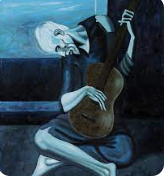
The Old Guitarist (1903-1904) by Pablo Picasso
The Artistic Movement Associated with the Work of Art
Picasso began working on The Old Guitarist at the end of 1903, completing it at the beginning of 1904. An elderly, blind, and frail homeless man is depicted in the painting, hunching over and clutching his guitar. Picasso created several works that depicted the suffering of the working class, the sick, and “those cast out of society.” For the entirety of 1902, Pablo Picasso lived in poverty. It was meant to be symbolic of life on Earth.
The Style of the Artist
Picasso began working on The Old Guitarist toward the end of 1903 and completed it the following year. Picasso’s “blue period” (1901–1904) was characterized by gloomier, oil-painted works in shades of blue and blue-green as the artist dealt with personal difficulties. The gloom of hunger and poverty permeated much of his art at the time. Therefore, the blue time period was symbolic of the hardships he faced during his own life (Bourached & Cann, 2019). Picasso’s art evolved through several distinct phases, including what has been called “the Rose Period,” “the African Period,” “Cubism,” “Neoclassicism,” “Surrealism,” and “later work.” Picasso’s “cubist” art is instantly recognizable. Instead of being constrained by what the eye sees, cubism allows for a much wider range of possible compositions. With his use of found objects, the invention of modern collage, and questioning the idea that mastery of classical technique was suggestive of artistic genius, his painting designs radically evolved throughout his life, and he helped question and reframe countless elements of painting and sculpture. Overall, Pablo Picasso stood out from the crowd because of the many innovative approaches to art he pioneered.
The Influences that Shaped the Work
His father, Pon Jose Ruiz Blasco, was a drawing instructor at a museum, and this experience profoundly impacted Pablo Picasso. In addition, Paul Cezanne was an inspiration for him. According to Pablo, “Cezanne is my only master.” Picasso incorporated cubism into his artwork largely because of Cezanne’s influence (Ali et a., 2022). Collage was the artistic medium that ultimately inspired him to move away from cubism.
Moreover, Picasso was affected by the past. Examples include “Les Demoiselles d’Avignon (1907),” alluding to a multitude of prior antecedents even while overturning them.” On the other hand, around the time The Old Guitarist was filmed, blind figures like the older adult were common in the literature associated with the symbolist movement. The musician’s frail appearance “originated in art from Picasso’s native country, Spain.” His “stretched limbs and constricted angular posture” “recall the figures of the great 16th-century artist El Greco,” says the blind musician.
Ways research enhanced my appreciation of the artwork.
My appreciation for Picasso’s art grew as I learned more about the artist’s life and career. He has a significant impact due to his dedication and enthusiasm for his field. Picasso’s paintings often veered into abstract territory. Additionally, one of the most remarkable abilities that set him apart was his ability to efficiently distill a topic down to its essential components by eliminating the fluff and zeroing in on the meat. The beautiful guitar in The Old Guitarist stood out starkly against the somber grayscale hues of the rest of the painting, so it was the first thing I noticed.
Interpreting understanding the context of artwork
Realizing the historical setting is crucial for developing an emotional bond with the artist’s works of art. Picasso’s “blue period,” in which he painted in shades of blue and blue-green, is an example of this kind of gloomy, moody painting. The goal of this artwork was to symbolize the right to vote for all citizens. Because of this, he understood the historical background of an artistic piece is essential to appreciate it fully.
References
Bourached, A., & Cann, G. (2019). Raiders of the lost art. arXiv preprint arXiv:1909.05677. https://doi.org/10.48550/arXiv.1909.05677
Ali, R. H., Rhodeghiero, K., Zuch, A., Syed, S., & Linstead, E. (2022). An Application of Neural Embedding Models for Representing Artistic Periods. In International Conference on Computational Intelligence in Music, Sound, Art, and Design (Part of EvoStar) (pp. 325-340). Springer, Cham. https://doi.org/10.1007/978-3-031-03789-4_21
Pablo Picasso. (n.d). The Old Guitarist, 1903 by Pablo Picasso. https://www.pablopicasso.org/old-guitarist.jsp
 write
write